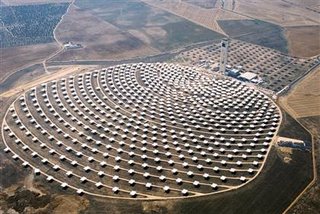I noticed today that many people in my neighbourhood [including our ourselves], took advantage of the unseasonably warm weather to get the Christmas lights put up around the outside of the house.
This commencement of the Christmas decorating once again brought to the forefront a conflict I face every year.
On one hand, I love the twinkle of the brightly coloured lights, the warmth and radiance of a fire in the hearth and the serene beauty and wonderful scent of a freshly cut Christmas tree all decorated and dazzling.
Whereas, the other half of my brain is looking at the energy waste, pollution and questionable forestry practices.
The solution for me, like many things, lies in compromise and being aware of 'green options'.
For example, our outdoor lights are not only on a timer, but a light sensitive timer that is readily available at most hardware stores. All that we do is set the length of time we want the lights to be on after dark has set. There are two advantages with this system. One, we never have to worry about forgetting to turn off the lights; and two, from a security perspective, our lights go on whether we are home or not.
I would also suggest taking a look at the LED Christmas lights that are now on the market. The advancement that has been made with this product segment in the last few years is quite astounding!
As for the Christmas tree, in the past we have purchased a live tree from the local nursery to plant permanently in the backyard [or some other spot] come spring. The downside with this is that a 3' tree really does not meet the Christmas image our eleven year old son has in his mind.
To accommodate this we have started buying a fresh cut tree from either a charitable organization [Boy Scouts] or from Ikea that has a 'plant a tree' program associated with their tree sales.
The final component that makes this fresh cut tree as eco-friendly as possible is that in January we are fortunate enough to have a city tree pick up program whereby all the trees are chopped up and used for paths in the local park system.
The fire in the hearth is a little bit more difficult for me to figure out an earth friendly method. Fortunately, we do not have a fireplace, so I do not have to wrestle with this issue very often. As near as I can tell, the biggest problem with fireplaces is the fine particulate that is released into the air. Just think when you go by a house that has a fire burning that you can smell it. That smell is proof of the fine particulate that appears to be a much greater pollution problem then was initially thought.
There are a couple of solutions to this problem. One, burn those 'fake logs' that burn clean; alternatively, make sure the wood you burn is as dry as possible as this will decrease the smoke [aka fine particulate]. Finally, if you are looking at a new fireplace, take a look a some of the new technology involving high efficiency technology that will facilitate the maximization of heat, but minimization of pollution.
The good news is that increasingly people seem to be looking for real ways to be gentle to the earth while at the same time be understanding that a Christmas without sparkly lights is somehow just not right!



